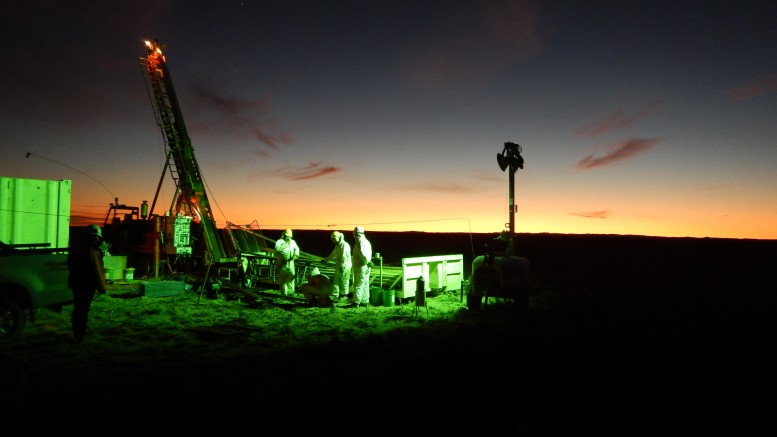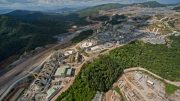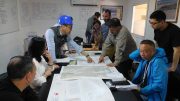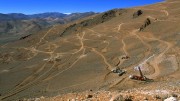VANCOUVER — In a hallway at the Sprott Natural Resource Symposium in Vancouver in July, Mirasol Resources (TSXV: MRZ) president and CEO Stephen Nano thumbs through a number of geological and geophysical maps, and lists off the scientific criteria that drew his company to acquire ground in Argentina’s Santa Cruz province and Chile’s Puna mineral district belt.
Mirasol has already reported positive drill results from its greenfields Claudia gold-silver project, 150 km northwest of Puerto San Julian in Santa Cruz province. Claudia is a joint venture with Cerro Vanguardia S.A. (CVSA), which is 92.5% owned by AngloGold Ashanti (NYSE: AU) and 7.5 %-owned by Santa Cruz provincial mining company Fomicruz.

Project location map of partners Mirasol Resources and AngloGold Ashanti’s Claudia project. Credit: Mirasol Resources.
The project is beside CVSA’s Cerro Vanguardia open-pit and underground gold mine, which produced a record 278,000 oz. gold in 2015 at a total cash cost of US$625 per oz. gold, and has reserves of 14.9 million tonnes of 2.55 grams gold for 1.2 million oz. gold.
The JV partners reported assays for 18 of the 26 drill holes that tested a 2 km long vein in Claudia’s Curahue prospect. The low sulphidation, epithermal-style vein is one of five prospects that occur in a 15 km vein corridor, as defined by surface sampling and geophysical anomalies.
Drilling at Claudia intercepted 66.5 metres of 0.42 gram gold, including 1 metre of 5.15 grams gold, as well as 39.5 metres of 0.7 gram gold. (Nano cautions the assays come from reverse-circulation drill holes that found groundwater at depth, which means water could flush through the hole and smear gold grades over longer intervals.)
He says that CVSA still has 2,000 metres of drilling left to finish its earn-in requirements this year, and is drilling diamond holes to confirm mineralization width.

Gradient array geophysical surveys at Claudia ha
“I’m not doing the discovery dance quite yet, but these are the kinds of grades you’d want to see,” Nano says. CVSA “is after high-grade and heap-leachable material because they’re in a hurry to find a satellite deposit to support their Cerro Vanguardia operation. So far, our work at Claudia meets that criteria, and our geophysics reliably suggest that the mineralization has a lot more room to grow.”
Under the joint venture signed in March, CVSA can earn 51% of the project by drilling 12,000 metres, spending US$5 million and paying US$1 million in stages over two years. CVSA can earn 75% over six years by reaching a production decision to mine a minimum 350,000 oz. gold resource, and funding Mirasol’s remaining 25% interest.

Project location map for partners Mirasol Resources and Yamana Gold’s Gorbea project in northern Chile. Credit: Mirasol Resources.
Nano says Mirasol’s other joint-venture partner, Yamana Gold (TSX: YRI; NYSE: AUY), has similarly encouraging results at their Gorbea gold-silver property in Chile, following a 5,500-metre drill program targeting mineralization at the property’s Atlas prospect.
In April, the partners released assays of 40 metres of 1.38 grams gold and 17.9 grams silver, plus 54 metres of 0.35 gram gold and 5.5 grams silver. Mirasol expects Yamana will ramp up its second field season at Atlas by November.
“The intersections are deep but they’re the right kind of grades, and we haven’t tested what’s above, so we could very much be drilling into a large and oxidized epithermal deposit,” Nano says. “We’re making ore-grade-like intersections, and that’s a great step forward.”
Yamana signed on with Mirasol in June 2015 by committing to spend US$10 million on exploration and US$2 million in cash payments over four years to earn a 51% interest in the property. Yamana would then have two years to earn 65% by delivering a preliminary economic assessment on an indicated resource of more than 1 million oz. gold.
Yamana can earn 75% the next year by completing a feasibility study and reaching a production decision and funding Mirasol’s 25% interest to production..
As of May, Mirasol had $18.7 million in cash. Shares of the company have traded within a 52-week range between 72¢ and $3.38 per share. With 44.7 million shares outstanding, the company has a $128-million market capitalization.






Be the first to comment on "Mirasol hunts for gold in Argentina, Chile"